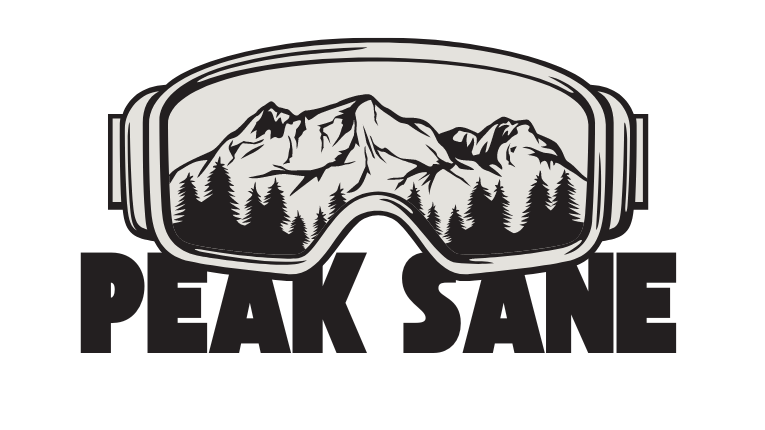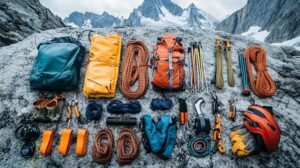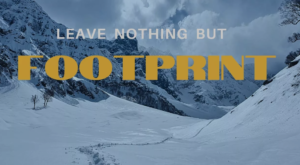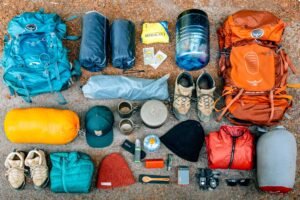A Case for Building Resilience: Mental Preparations in Tough Mountaineering Expedition
Climbing mountains is more than just a test of physical endurance and sheer will — it also tests the mind, the mental gravity that can take even seasoned climbers to their breaking point. More than 20 years in the mountains and many summits later, after leaving every bit of myself on peaks where I have been tested in body, mind and spirit, I know this one incredibly profound truth; mental conditioning is as paramount to us climbers as physical conditioning.
From conquering your first seriously tough climb, to preparing for a week long venture into the most unforgiving environment possible — mental resilience can be make or break. I will be sharing some of my thoughts and strategies on how to mentally prepare yourself during one such predator journey — the challenging mountaineering expedition.
Understand the Mind Battels of Mountaineering
Mountaineering challenges your mind in so many ways:
Fear of the unknown: Mountain environments are inherently unpredictable; they can be full of surprise changes in weather and route difficulty.
Physical discomfort: Consistently long days of being cold, hungry, and tired can push you to your mental brink.
But it can feel isolated — far from your bedroom, surrounded only by the elements and the night.
Struggle to adjust to high altitudes: Higher altitude has the ability to impact you phsyiologically making it harder to breathe causing other common issue like headaches, dizziness and nausea which can make your concentration levels decrease.
Knowledge is the first step to preparing yourself: knowing that you will be faced with many obstacles. But how can you prepare your mind for this?
1. Namely, visualize success and be ready for setbacks.
Why Visualization Works
Athletes, performers, and all good mountaineers use visualization to pre-experience the hardships ahead. The idea is straightforward: your mind and body are more likely to deliver the image of you as a success if you can visualize yourself becoming one.
Visualizing success helps to:
Confidence in yourself is number one.
Know your potential stumbling blocks
Pre-climb to destress and relax
Apply Visualization to Mountaineering
In the weeks prior to your climb and on a daily basis before you depart for your adventure, close your eyes and envision every part of that climb. Visualize getting through the tough times, riding the hard parts of that route, and making it to the top. Just feel that clean mountain air blow through your mind as you peer down over the landscape. At the same time prep yourself mentally for setbacks. Think about the weather to happen, what if your gear going out of order and fatigue on Responding on Things that occur suddenly.
In addition to increasing confidence, this type of mental rehearsal also helps improve the way your mind deals with unexpected events by practicing finding solutions in your imagination. And when you have to creatively figure out a way around them —because if you’re visualizing experiencing setbacks then the story of visualization will allow for it— you’ll respond with the confidence that you’ve “experienced” this already.
2. Take Tiny Steps Up the Mountain
The scale of the challenge as you stand at the bottom of a great big mountain can easily make one FEEL small. This is where you can break up an expedition into smaller easily managed segments.
The Power of Little Goals to Boost Mental Resilience
When it comes to cognitive load, it is easier to complete small goals instead of the entire climb. Whether you call it “chunking” (or some variation of this strategy), this technique will keep your mind from conjuring up those awful thoughts about how far off you are. Rather, you remain in the here-and-now, focused on getting to the next waypoint or summiting the next pitch.
Implement this into your climb
Pick safe, natural points at which you can stop, rest, or regroup and look up your route carefully before the expedition. This could take the form of base camps, intermediate altitudes, or stretches that present specific challenges along the way. Instead of aiming for the summit, focus more on achieving these smaller goals one step at a time.
And when the shit is really hitting the fan, you ask yourself “What do I need to focus on in the next hour? How in the world do I get up to that ridge?” This also helps keep you mentally on track so that the steady climb up a mountain never seems insurmountable.
3. Embrace the Challenge: Learn to Train Uncomfortably
Embracing Discomfort (& Why You Should)
Mountaineering is inherently agonizing. You will at some point deal with freezing winds, altitude sickness, appetite and fatigue. Any training you do in the gym should complement this idea of learning to be uncomfortable….
How to Build Mental Toughness for the Things We Avoid
Cold Weather Training: Hike in rain and wind to get used to the worst case scenario from a mental and physical perspective. This will help you acclimatize to what these conditions feel like so that it is less of a shock when you experience these on the expedition.
Lack of sleep: acclimatise to functioning on less sleep by hiking overnight and sleeping in the hills without breaks. As well as preparing your mind for the sleep challenges of high-altitude expeditions.
Extended training sessions: Test your spirit with longer difficult hikes or runs that test the amount of time you can endure. The same goes for the mental guts it takes to continue when you simply can no longer run as fast — that grit is what will be useful on the mountain.
Training in adverse conditions will allow you to appreciate discomfort and accept it. You will no longer feel the cold or fatigue, your brain now understands they are transient and you have the self-belief to keep going.
4. Control Your Fear and Stress
Stress and Fear in the Mountains
And then, fear is the right response when you’re about to pull a ledge with a thousand feet of airy exposure beneath or you get your ass caught in an alpine storm fifteen miles from civilization. If you are able to deal with that fear and stress is a major aspect of mental conditioning for climbing.
Stress Management Techniques
Calming Breathing: It is another deep breathing technique that calms your central nervous system. Practising breath control can help lower your heart rate and reduce panic/anxiety.
Exercise #4: Mindfulness and Meditation — Meditation can also help to keep you right in the present-day, not hypertrophying any maybe negative thing that could happen. Practicing in your warm ups during classes will help you to practice staying calm during high stress.
Optimistic banter: one of the simplest ways to stray into darkness, is thru negative thoughts. Counter balance this with positive self-talk. If you have a test or event this could before car, at school, or etc Reassure yourself with sayings like “Ive trained for this”, “I am able to do this”, “One both feet in resting.
How to Desensitize Fear
The only option to remove fear and face it is by facing it in certain limits. For those of you with a fear of heights, this could be the exposure therapy part where eventually your climbs get higher and higher. Get started with 0-3 scramble hikes in the low altitudes. The more you face those fears in a controlled setting the less daunting they will be in the mountains.
5. Build a Strong Support System
Why Team Dynamics Matter
Mountaineering is frequently a group activity so fostering a good team environment can be instrumental to remaining mentally strong. Friendship, guiding or mountaineering team. It is nice to have someone who inspires you by sound of voice and good company.
Choosing the Right Team
By having positive folks around,people seeking the same future and have that ‘can-do’ attitude to challenge head on. I think given that their lives are so carefully regimented, a university is an excuse for them to kind of ‘cut loose”), buttheir new home also means they will no longer be part of any group in which members have each others back and can help relieve stress/anxiety in tough times.
If you are traveling and climbing solo, keep in touch with your network of help until then back home. Keeping in touch with family or friendly adults can give you a little boost of morale, they might encourage and remind you that you are not entirely by yourself in the process.
6. Adaptable: The Art of the Unexpected
Why Flexibility is so Important in Mountaineering
Mountains are unpredictable. Weather can turn on a dime; roads can be washed out or snowed in due to the difficult terrain and plans will need to be flexible. Understand that some of these problems may come your way and that preparation is the key to handling them when they do. [segments]
Developing an Open Mind
You can build the willpower to mentally prepare for a challenging paradise mountain climb through adaptability. Now on developing that skill.createObject
Be Prepared: Be sure to thoroughly research your tracks and know the potential hazards. The more you know the better equipped to make decisions in unpredictable scenarios.
Improvise: Give yourself situations to adapt to on training hikes or climbs. For instance, deviate from your planned route or add an unplanned element (try going off trail without a map, or practice self-rescue skills).
Welcome to Plan B: Back up plan is welcome. Always be well aware to prepare mentally if the weather goes wrong or your route becomes very dangerous, so better to return or decide on deviation. Sometimes in the field, that might mean the difference between a successful expedition and disaster.
7. Building Mental Strength With Repetition Build Your Barbell
But this sense of mental toughness is not cultivated overnight—it is developed through time and experience. The longer you stay in the mountains, the more resilient you will be to take on some of their harshest climbs.
Building Mental Toughness Takes Time
This means regular exposure to mountaineering, or difficult hikes. If you better expose your brain and your body to the mountains, handling them become more skilled in it.
Increase the difficulty incrementally — as you become more comfortable with climbing, challenge yourself to take on harder and different routes409×508 Now as you can apply it into full training, you will do this gradual progression which builds up your mental and physical endurance.
Remember successes: After every trip, remember notable cruxes and what you did in response to them. I promise you, that will teach you all types of things about yourself. What strategies worked best? It is through your experiences that you grow and get better.
Conclusion: Preparing For Your Next Mountaineering Expedition With Mental Resilience
Mountaineering is a sport of the mind as well as body. Seeing success clearly in their mind, breaking things down and taking little steps to achieve that.
By getting comfortable with discomfort, managing with stress, building a fortress of support around yourself, and remaining adaptable you develop the mental resilience required to tackle even the steepest climbs.
It all takes practice, because mental strength, like any other skill, is not something you are born with; it is something that can be developed. The mountains will put you through scenarios that are impossible to predict, but with a strong head you can take on those battles headfirst.
Therefore, before embarking on your next adventure, also practice the training of mind along with body. The summit will be there for you, and with the mental strength that you have honed now, its is yours to be had.
If you follow these mental preparation techniques, not only will your climb be more successful, but also more fulfilling and enjoyable. The reality is the summit is just a blip in the journey, its about all of that head and heart stuff you do on the way there that really has value.




